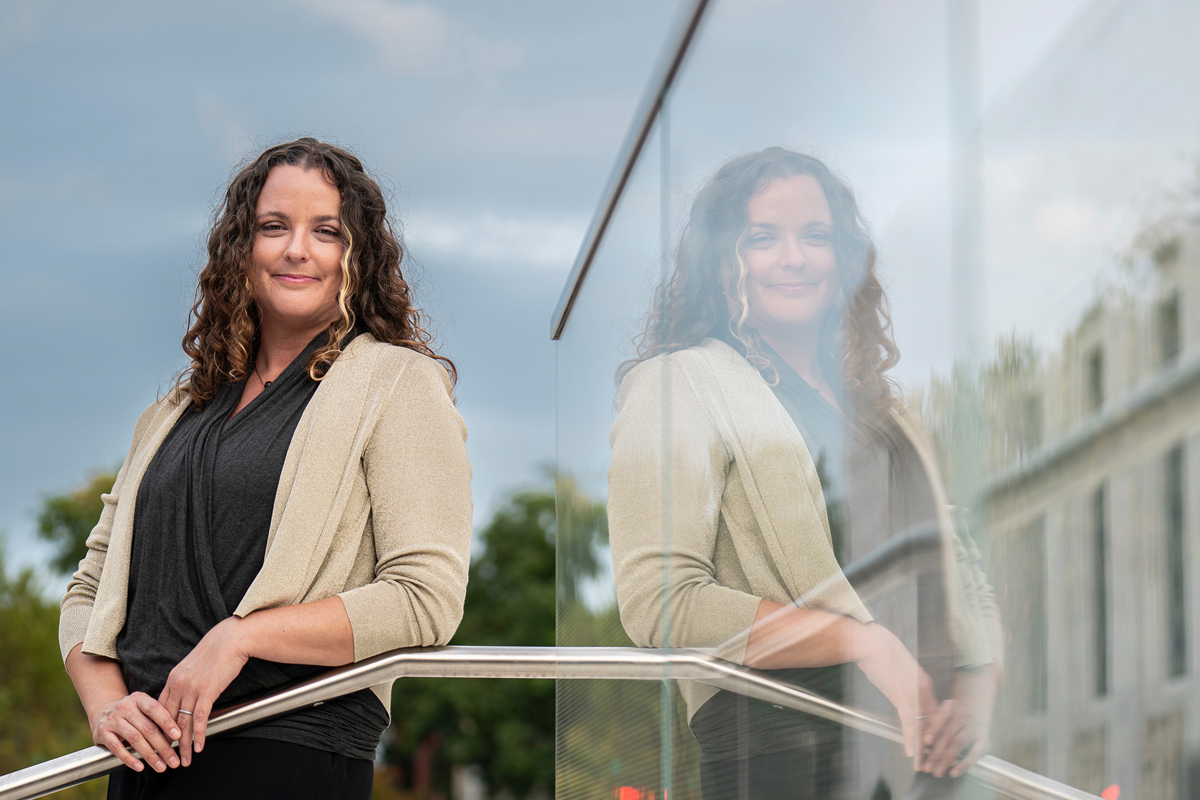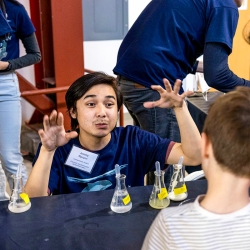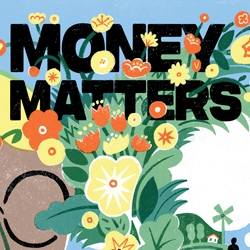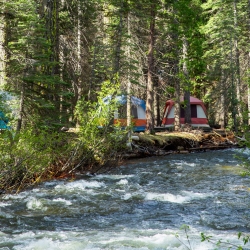
Photo by Denny Henry
By Ben Fong-Torres
What we did this summer: We baked under record heat; we ran from wildfires and watched a beloved tourist town in Hawaii burned to a crisp. We weathered both droughts and floods, and pollutants and poisons in the air — all courtesy of the phenomena collectively known as climate change.
What we’ll do this winter: Those of us who care – citizens as well as educators, corporate leaders and politicians – will study the fifth National Climate Assessment, or NCA5, described by Axios as “the most comprehensive and authoritative federal climate report that goes through the U.S. region by region, with specific projections for economic sectors and ecosystems.”
To oversee the report, due out in November, the Biden administration appointed an SF State alum, Allison Crimmins. In 2006, Crimmins earned an M.S. in Marine Science before moving on to Harvard Kennedy School, where she received a master’s in public policy. She worked with the U.S. Global Change Research Program in 2016 before joining the Environmental Protection Agency, where she remains.
Ben Fong-Torres: I’d like to know where you’re from and how you got into science.
I grew up in Indiana and so, because I had never seen the ocean before, I thought it would be a brilliant idea to start studying marine biology, even though I went to Michigan State for my undergrad. Because it would force me to one day get to see the ocean.
When I finished, I had saved up all my marine biology classes. And I studied abroad in Australia and took them there, on the Great Barrier Reef. It ended up being a great plan, and that is what led me to move to California and go to school at the Moss Landing Marine Laboratories, which [was affiliated with] San Francisco State’s master’s in Oceanography program [through a CSU partnership]. And I’ve always been interested in climate change. So when I came to Moss Landing, I knew I wanted to do something with the ocean and something with climate change. And that led me to become a paleoceanographer, where I was digging up deep sea ocean sediment to reconstruct past climate change.
How far back does your interest in climate change go?
Even when I was a little kid, my parents tell me I had the “Save the Whales” posters on the wall. And almost as soon as I learned what climate change was, to me, that was the big problem that needed solving.
How did your experience at Moss Landing Marine lab help shape your career?
It was huge. It was a really immersive program. Its location, right in the middle of Monterey Bay, at the head of the underwater canyon and at the head of an estuary, was just the perfect spot to be in all sorts of different environments. It was an opportunity to learn how to do science, but more importantly, how to ask the questions that need asking.
What’s been your work at the Environmental Protection Agency?
I’ve been at EPA about 12 years, and it was a perfect place to work because it married the science, the policy and the communication elements of what I like to work on. For the first eight years, I was in the climate science and impacts branch, working on assessments of climate risks and impacts, and in particular the impacts of climate change on human health. That’s where [in 2016] I led the special assessment on climate impacts on health.
I’m really proud of that assessment. We felt that the subject of health was a ripe topic that deserved more treatment than we could put into a National Climate Assessment. We looked at impacts across extreme heat and air quality and extreme weather events and waterborne and foodborne disease. It’s the first time we really delved into the impacts on mental health. A strong emphasis of that report was on vulnerable populations, so all the ways that climate change disproportionately affects different communities, whether it be low income or people of color. There’s a section on women and pregnant women, and on children, older adults — all of these communities who are either more exposed or more sensitive to climate change.
Then, about four years ago, I moved to a different part of EPA, where I’m doing more research coordination across the agency. But it’s from there that I was detailed to the White House Office of Science and Technology Policy, and that’s where I am today, directing the fifth National Climate Assessment.
What is your work as the director?
I am responsible for the vision of this assessment — thinking about where it should go and how it should be different from the assessments that have come before. I’m the chair of the Federal Steering Committee, which is made up of a member from each of the 14 member agencies that developed this assessment. A huge part of my job is coordinating about 850 people and trying to get them to all move in the same direction. We have 500 authors and 250 contributors from every state in the U.S. — just a broad swath of expertise.
You’ve talked about wanting to make the assessment more accessible to more people.
We’ve been working to make sure that this isn’t just a book that gathers dust on a shelf, that it’s a tool for people to use and make informed decisions about the climate risks they’re facing. Some of the things we’ve been working on include making sure our website is navigable. It’s a huge report. It’s something like 2,200 pages, so how do you find the information that you need? We want to make sure that our website serves that function.
This is the first time that the report is being officially delivered as a website (globalchange.gov). The website is the report of record. It’s important that we make sure that the website makes it easy to find, share and download things.
We had our first call for art, so there is some beautiful art that was submitted to us from all around the country. And then we’re doing some fun things like creating podcast episodes, which hopefully will serve as a little more friendly entry point into the report.
It sounds like this report could be more fluid than any previous report, in that you could even add to it as it goes along so that it's not locked in place.
That’s a cool idea.
Happy to help. What do you think individuals, including our alumni, can and should be doing about climate change?
I think probably the most important thing is to talk about climate change, and the second most important thing is to find others to do work together. They can be inspired by that work. … In this report, we’ve included case studies where communities all around the U.S. are taking mitigation and adaptation actions. And it was nice to highlight that in this report because it can inspire other communities.
What should educators be doing to add to kids’ knowledge about climate change? And how do you feel about the younger generation?
We’ve had a lot of interest from the climate, education and literacy community. They submitted a lot of public comments. I think there are a lot of ways educators can be using this report. I know a lot of late high school college-level courses that use our table of contents as their syllabus. It’s also a huge body of authors that serve as role models for potential careers, and so we look for ways to get youth and early-career students involved where we can.
I am really energized by the youth. I love to see how active and involved they are. It’s a tough topic that can certainly be anxiety inducing, but I’ve also seen that they have a lot of courage and that they are moving forward on climate action against all hurdles, so they give me courage too.
One change that I’ve seen just in the last few years, from educators, students and youth, is less of a call for information on basic climate science. I’ve seen [fewer] young people asking for that kind of information, and more of them asking for information on what we should be doing, which I love. I think it’s a great turn in the conversation because we don’t have to always start from square one of “Climate change is real, and it’s us, and it’s bad.” We’re having a conversation about what we should be doing about it.
I recently saw two essays about climate change. One was headlined, “Yes, Global Warming is Accelerating,” and the other was “The Clean Energy Future Is Arriving Faster Than You Think.” Are they both right?
Absolutely. And it’s exciting to see that part of this assessment, because that’s the part that gives you a lot of courage. We have seen drastic reductions in the cost of wind and solar and EV batteries, and we’ve seen rapid increase in the capacity of solar, wind and battery storage. We also know that the increase in climate mitigation-related jobs will outpace the decrease in fossil fuel-related jobs. We’re also seeing a shift in our workforce as well as these energy systems. We have a long way to go, but I have been pleasantly surprised and energized by how fast we’ve come just in the last five years.
Features

Forces of Nature
Through teaching, research, practices, activism and so much more, the University works every day to protect our planet.

Money Matters
Forward-thinking alumni, students and faculty are demonstrating how investors can bankroll sustainability (and turn a profit doing it).

A River Runs Through It
In some ways SF State's best-kept secret, the Sierra Nevada Field Campus is a bastion of science, art and learning in the middle of the wilderness.